FlareOn11
Flare-On 11 (2024)
Get the binaries from the Flare-On website and Flare-On 11 stats and solutions by Mandiant team.
1 Frog
Run frog.py. You need to move the frog through a maze to reach the statue.
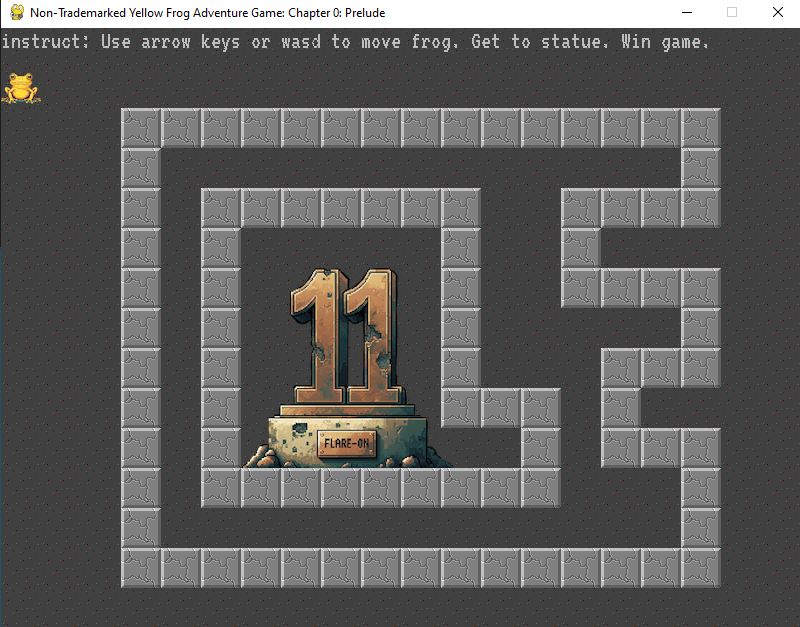
Reading the provided challenge code i found the following snippet:
victory_tile = pygame.Vector2(10, 10)
along with the flag generation function :
def GenerateFlagText(x, y):
key = x + y*20
encoded = "\xa5\xb7\xbe\xb1\xbd\xbf\xb7\x8d\xa6\xbd\x8d\xe3\xe3\x92\xb4\xbe\xb3\xa0\xb7\xff\xbd\xbc\xfc\xb1\xbd\xbf"
return ''.join([chr(ord(c) ^ key) for c in encoded])
so i just ripped the flag generation function out and called it with the victory_tile coordiates as function arguments as such:
def GenerateFlagText(x, y):
key = x + y*20
encoded = "\xa5\xb7\xbe\xb1\xbd\xbf\xb7\x8d\xa6\xbd\x8d\xe3\xe3\x92\xb4\xbe\xb3\xa0\xb7\xff\xbd\xbc\xfc\xb1\xbd\xbf"
return ''.join([chr(ord(c) ^ key) for c in encoded])
print(GenerateFlagText(10,10))
and the result was
Flag: welcome_to_11@flare-on.com
2 Checksum
We are basically provided with a PE executable called checksum.exe, upon running it outputs:

Without wasting time I cracked open this program in IDA Pro, turns out it’s written in Golang with full debug symbols. Program’s got exactly three non-library functions: main_main, main_a, and main_b. That’s it. Either this thing is gloriously simple, or it’s hiding eldritch horrors inside b. But hey, at least it looks like I won’t need to sell my soul to reverse engineer it. Small mercies.
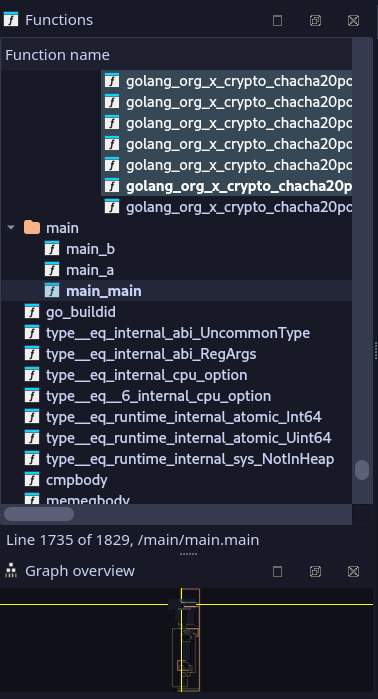
Since it is Go, let’s go to main_main function. First, we are met with a for loop. In each loop, it generates two random values and ask the user to input the sum. It does this for a random number of times. However, this part does not contribute to the following process, so we can safely ignore it.
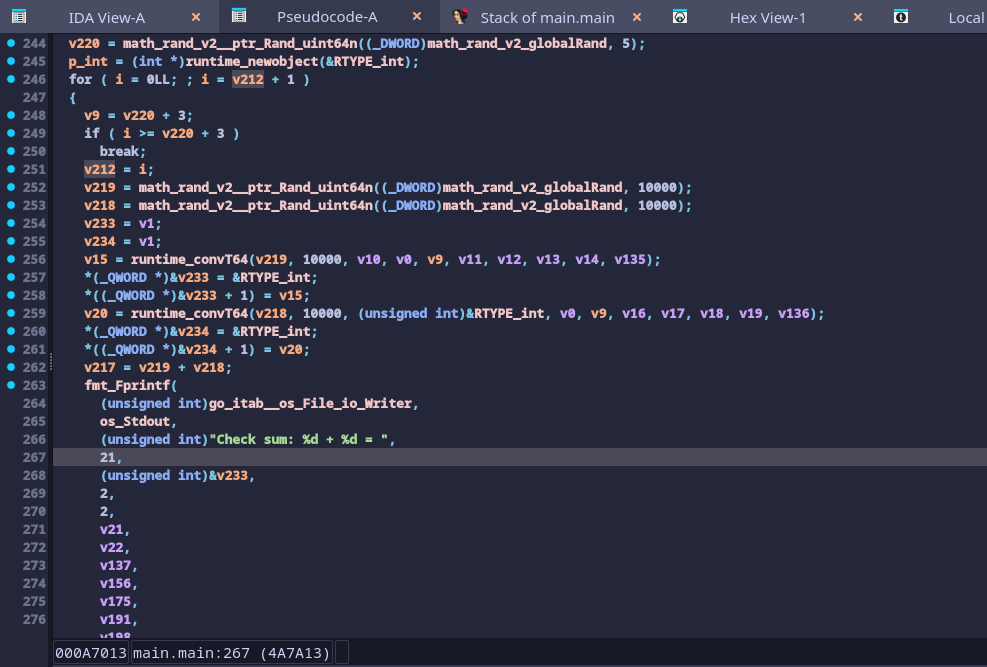
After the for loop, it asks for a new input “Checksum.” Based on the checks after input, it needs to be a hex string which decodes to a 32-byte data. Using this decoded 32-byte data as a key, it creates a XChaCha20-Poly1305 AEAD cipher (notice the X here). Then, it passes in a data buffer with the name main_encryptedFlagData along with its size.

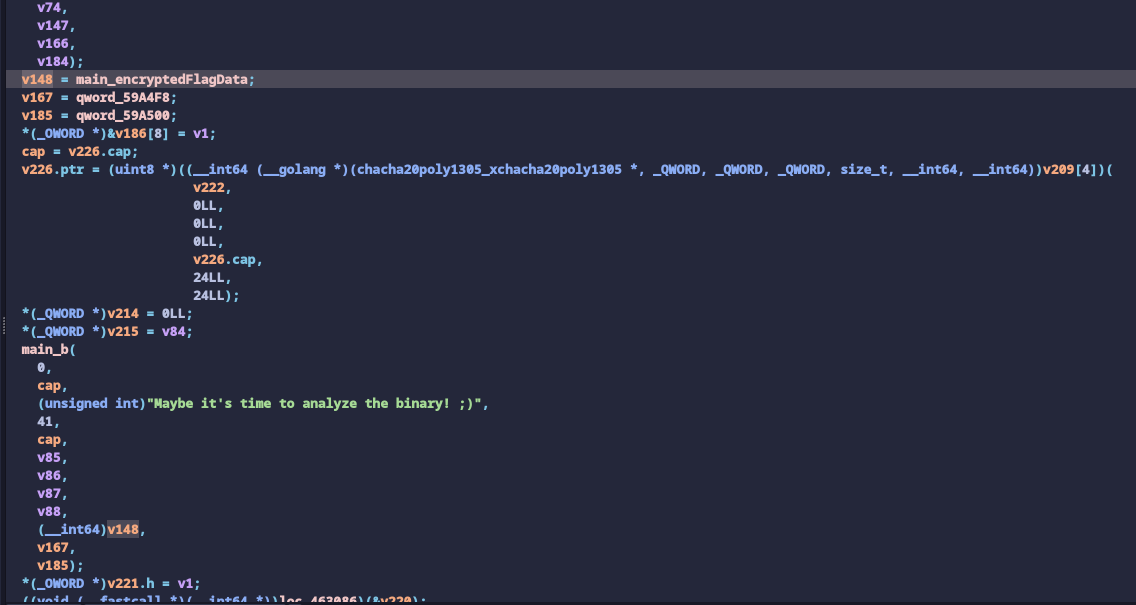
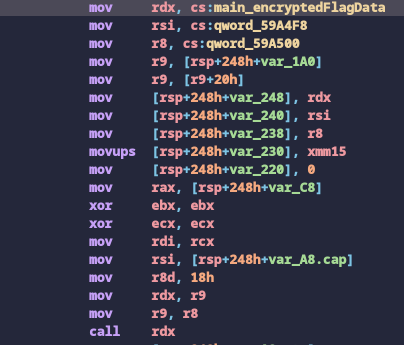
Looking a bit deeper into the library’s documentation, we see that the crypto algorithm’s key size must be 32-bytes with 2 different nonce sizes. The 12-byte nonce is used for the standard ChaCha20-Poly1305 variant, while the 24-byte nonce is used for the XChaCha20-Poly1305 algorithm.
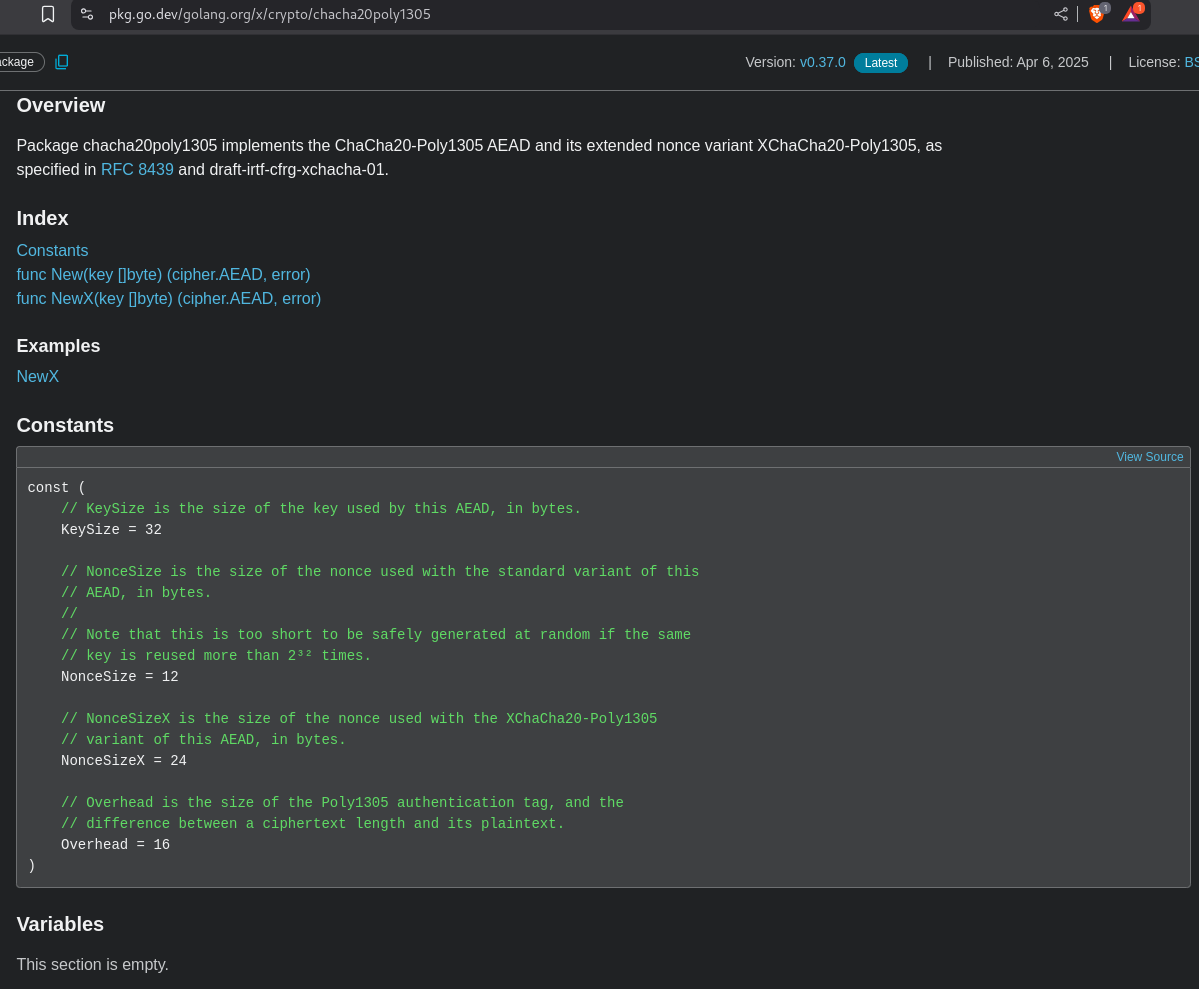
We don’t know the key yet. It is also non-brute-forceable as it is 32 bytes long. Let’s continue reading the code:
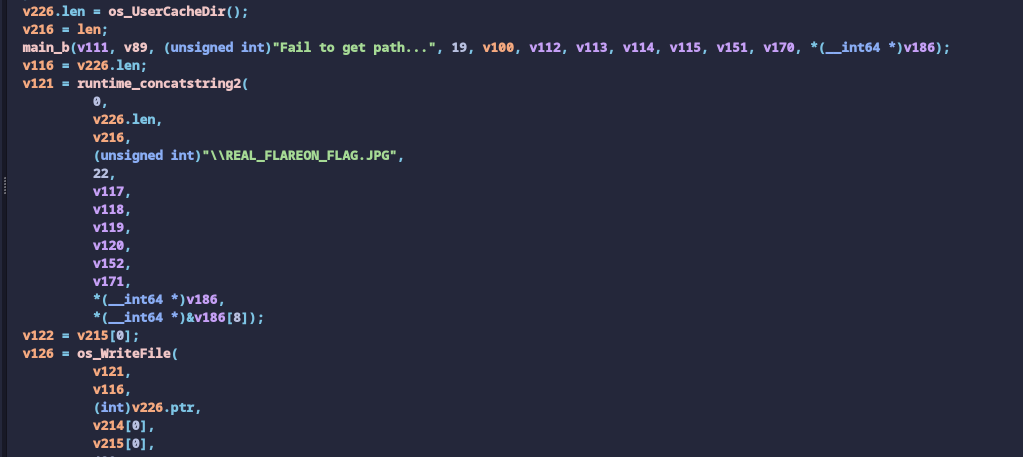
First, it uses SHA 256 to hash the decrypted data. Then, it turns the hash into hex and compare it with the input hex string (checksum). If it is the same, it calls function main.a with the input hex string. If the function call returns true, it will finally output the decrypted data to
{os.UserCacheDir()}\REAL_FLAREON_FLAG.JPG.
So let’s take a look at what main_a does—it’s actually not that complicated. We see that it first XOR’s the input string with a constant string FlareOn2024. Then it encodes the XOR’d string to base64, and compare it with a constant string cQoFRQErX1YAVw1zVQdFUSxfAQNRBXUNAxBSe15QCVRVJ1pQEwd/WFBUAlElCFBFUnlaB1ULByRdBEFdfVtWVA==.
for ( i = 0LL; a2 > i; ++i )
{
a5 = v9;
v17 = v15;
v18 = i - 11 * ((__int64)((unsigned __int128)(i * (__int128)0x5D1745D1745D1746LL) >> 64) >> 2);
v19 = v15[i];
if ( v18 >= 0xB )
runtime_panicIndex(v18, i, 11LL);
v10 = "FlareOn2024bad verb '%0123456789_/dev/stdout/dev/stderrCloseHandleOpenProcessGetFileTypeshort write30517578125bad argSizemethodargs(reflect.SetProcessPrngMoveFileExWNetShareAddNetShareDeluserenv.dllassistQueuenetpollInitreflectOffsglobalAllocmSpanManualstart traceclobberfreegccheckmarkscheddetailcgocall nilunreachable s.nelems= of size runtime: p ms clock, nBSSRoots=runtime: P exp.) for minTrigger=GOMEMLIMIT=bad m value, elemsize= freeindex= span.list=, npages = tracealloc( p->status= in status idleprocs= gcwaiting= schedtick= timerslen= mallocing=bad timedivfloat64nan1float64nan2float64nan3float32nan2GOTRACEBACK) at entry+ (targetpc= , plugin: runtime: g : frame.sp=created by broken pipebad messagefile existsbad addressRegCloseKeyCreateFileWDeleteFileWExitProcessFreeLibrarySetFileTimeVirtualLockWSARecvFromclosesocketgetpeernamegetsocknamecrypt32.dllmswsock.dllsecur32.dllshell32.dlli/o timeoutavx512vnniwavx512vbmi2LocalAppDatashort buffer152587890625762939453125OpenServiceWRevertToSelfCreateEventWGetConsoleCPUnlockFileExVirtualQueryadvapi32.dlliphlpapi.dllkernel32.dllnetapi32.dllsweepWaiterstraceStringsspanSetSpinemspanSpecialgcBitsArenasmheapSpecialgcpacertracemadvdontneedharddecommitdumping heapchan receivelfstack.push span.limit= span.state=bad flushGen MB stacks, worker mode nDataRoots= nSpanRoots= wbuf1=<nil> wbuf2=<nil> gcscandone runtime: gp= found at *( s.elemsize= B (";
v11 = (unsigned __int8)aTrueeeppfilepi[v18 + 3060];
*(_BYTE *)(a5 + i) = v11 ^ v19;
v9 = a5;
v15 = v17;
}
v20 = v9;
v21 = encoding_base64__ptr_Encoding_EncodeToString(
runtime_bss,
v9,
a2,
a2,
a5,
(_DWORD)v10,
v11,
v12,
v13,
v23,
v24,
v25);
if ( v20 == 88 )
return runtime_memequal(
v21,
"cQoFRQErX1YAVw1zVQdFUSxfAQNRBXUNAxBSe15QCVRVJ1pQEwd/WFBUAlElCFBFUnlaB1ULByRdBEFdfVtWVA==");
else
return 0LL;
}
So to get the input, all we need to do is to reverse this process:
import base64
key = b"FlareOn2024"
decoded_data = base64.b64decode('cQoFRQErX1YAVw1zVQdFUSxfAQNRBXUNAxBSe15QCVRVJ1pQEwd/WFBUAlElCFBFUnlaB1ULByRdBEFdfVtWVA==')
xored = bytes([b ^ key[i % len(key)] for i, b in enumerate(decoded_data)])
print(xored)
Gives us :
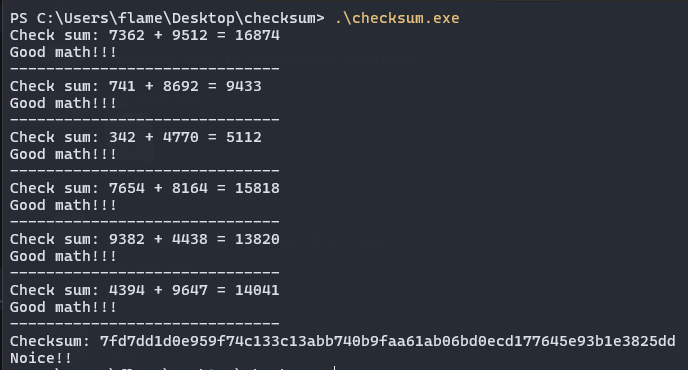
As we read previously , In the final part of the program’s main function, the program calls the API os.UserCacheDir to retrieve the
default root directory that stores user-specific cached data. On Windows, this path is the %LocalAppData% path. The program then proceeds to write the decrypted data content to the file REAL_FLAREON_FLAG.JPG in the %LocalAppData% folder.

Below is the image REAL_FLAREON_FLAG.JPG in the %LocalAppData% directory, which gives us the flag of Th3_M4tH_Do_b3_mAth1ng@flare-on.com.
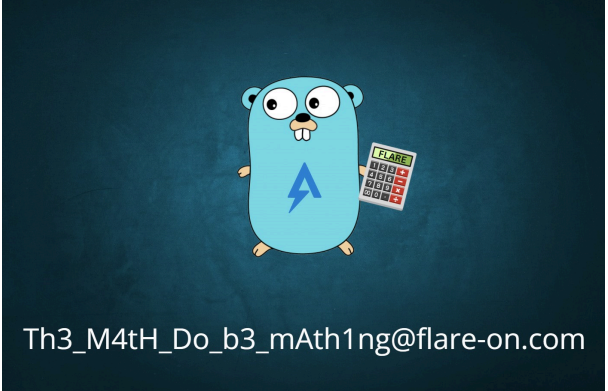
3 Aray
We are given a single aray.yara file. YARA file is basically a rule file for detecting certain file patterns. It is used widely in detecting malicious programs/files by antivirus softwares.
For the YARA file we are given, if we look at the condition section, we can see it’s basically hundreds of rules chained together using and. For a target file to match, we essentially want to satisfy all the conditions.
We can split the conditions into a few groups:
-
First, there’s a condition that checks if the file is exactly 85 bytes long.
-
Second, there’s a condition that checks if the MD5 hash of the file is b7dc94ca98aa58dabb5404541c812db2.
-
Next, there are conditions that use normal math operations. These are pretty straightforward, and we can directly turn them into Z3 expressions. Here are a few examples:
filesize ^ uint8(11) != 107 becomes filesize ^ flag[11] != 107 uint8(55) & 128 == 0 becomes flag[55] & 128 == 0 uint8(48) % 12 < 12 becomes ULT(flag[48] % 12, 12) -
Finally, we have conditions that involve hashes. At first, these look tricky because they seem hard to solve with Z3. But if you look closer, you’ll notice all the hash checks are done only on 2 bytes at a time.
Because of this, we can actually write our own functions to “solve” these hashes by brute-forcing or testing values until they work. first let write a simple awk query with sed and sort to extract the conditions:
awk 'NR==n-1' n=$(wc -l < aray.yara) aray.yara | sed 's/and /\n/g' | sort
which gives us the following:
filesize ^ uint8(0) != 16
filesize ^ uint8(0) != 41
filesize ^ uint8(1) != 0
filesize ^ uint8(10) != 205
filesize ^ uint8(10) != 44
filesize ^ uint8(11) != 107
filesize ^ uint8(11) != 33
filesize ^ uint8(12) != 116
filesize ^ uint8(12) != 226
filesize ^ uint8(1) != 232
filesize ^ uint8(13) != 219
filesize ^ uint8(13) != 42
filesize ^ uint8(14) != 161
filesize ^ uint8(14) != 99
filesize ^ uint8(15) != 205
filesize ^ uint8(15) != 27
filesize ^ uint8(16) != 144
filesize ^ uint8(16) != 7
filesize ^ uint8(17) != 16
filesize ^ uint8(17) != 208
filesize ^ uint8(18) != 234
filesize ^ uint8(18) != 33
filesize ^ uint8(19) != 222
filesize ^ uint8(19) != 31
filesize ^ uint8(20) != 17
filesize ^ uint8(20) != 83
filesize ^ uint8(21) != 188
filesize ^ uint8(21) != 27
filesize ^ uint8(2) != 205
filesize ^ uint8(22) != 191
filesize ^ uint8(22) != 31
filesize ^ uint8(23) != 18
filesize ^ uint8(23) != 242
filesize ^ uint8(24) != 217
filesize ^ uint8(24) != 94
filesize ^ uint8(25) != 224
filesize ^ uint8(2) != 54
filesize ^ uint8(25) != 47
filesize ^ uint8(26) != 161
filesize ^ uint8(26) != 44
filesize ^ uint8(27) != 244
filesize ^ uint8(27) != 43
filesize ^ uint8(28) != 12
filesize ^ uint8(28) != 238
filesize ^ uint8(29) != 158
filesize ^ uint8(29) != 37
filesize ^ uint8(30) != 18
filesize ^ uint8(30) != 249
filesize ^ uint8(31) != 32
filesize ^ uint8(3) != 147
filesize ^ uint8(31) != 5
filesize ^ uint8(32) != 30
filesize ^ uint8(32) != 77
filesize ^ uint8(33) != 157
filesize ^ uint8(33) != 27
filesize ^ uint8(34) != 115
filesize ^ uint8(3) != 43
filesize ^ uint8(34) != 39
filesize ^ uint8(35) != 120
filesize ^ uint8(35) != 18
filesize ^ uint8(36) != 6
filesize ^ uint8(36) != 95
filesize ^ uint8(37) != 141
filesize ^ uint8(37) != 37
filesize ^ uint8(38) != 8
filesize ^ uint8(38) != 84
filesize ^ uint8(39) != 18
filesize ^ uint8(39) != 49
filesize ^ uint8(40) != 230
filesize ^ uint8(40) != 49
filesize ^ uint8(41) != 233
filesize ^ uint8(41) != 74
filesize ^ uint8(42) != 1
...
hash.crc32(34, 2) == 0x5888fc1b
hash.crc32(63, 2) == 0x66715919
hash.crc32(78, 2) == 0x7cab8d64
hash.crc32(8, 2) == 0x61089c5c
hash.md5(0, 2) == "89484b14b36a8d5329426a3d944d2983"
hash.md5(0, filesize) == "b7dc94ca98aa58dabb5404541c812db2"
hash.md5(32, 2) == "738a656e8e8ec272ca17cd51e12f558b"
hash.md5(50, 2) == "657dae0913ee12be6fb2a6f687aae1c7"
hash.md5(76, 2) == "f98ed07a4d5f50f7de1410d905f1477f"
hash.sha256(14, 2) == "403d5f23d149670348b147a15eeb7010914701a7e99aad2e43f90cfa0325c76f"
hash.sha256(56, 2) == "593f2d04aab251f60c9e4b8bbc1e05a34e920980ec08351a18459b2bc7dbf2f6"
uint32(10) + 383041523 == 2448764514
uint32(17) - 323157430 == 1412131772
uint32(22) ^ 372102464 == 1879700858
uint32(28) - 419186860 == 959764852
uint32(3) ^ 298697263 == 2108416586
uint32(37) + 367943707 == 1228527996
uint32(41) + 404880684 == 1699114335
uint32(46) - 412326611 == 1503714457
uint32(52) ^ 425706662 == 1495724241
uint32(59) ^ 512952669 == 1908304943
uint32(66) ^ 310886682 == 849718389
uint32(70) + 349203301 == 2034162376
uint32(80) - 473886976 == 69677856
uint8(0) & 128 == 0
uint8(0) < 129
uint8(0) % 25 < 25
uint8(0) > 30
uint8(10) % 10 < 10
uint8(10) & 128 == 0
uint8(10) < 146
uint8(10) > 9
uint8(11) & 128 == 0
uint8(11) < 154
uint8(11) > 18
uint8(11) % 27 < 27
uint8(1) & 128 == 0
uint8(1) < 158
uint8(1) % 17 < 17
uint8(1) > 19
uint8(12) & 128 == 0
uint8(12) < 147
uint8(12) > 19
uint8(12) % 23 < 23
uint8(13) & 128 == 0
uint8(13) < 147
uint8(13) > 21
uint8(13) % 27 < 27
...
Conditions that are hashes at first glance seems impossible to be solved by Z3. However, we can write a small python script to manually solve for it using bruteforce since all the hashes are done only on exactly 2 bytes:
from hashlib import sha256, md5
from itertools import permutations
from zlib import crc32
targets = [
(lambda b: sha256(b).hexdigest(), {
"403d5f23d149670348b147a15eeb7010914701a7e99aad2e43f90cfa0325c76f",
"593f2d04aab251f60c9e4b8bbc1e05a34e920980ec08351a18459b2bc7dbf2f6"
}),
(lambda b: md5(b).hexdigest(), {
"89484b14b36a8d5329426a3d944d2983",
"f98ed07a4d5f50f7de1410d905f1477f",
"657dae0913ee12be6fb2a6f687aae1c7",
"738a656e8e8ec272ca17cd51e12f558b"
}),
(lambda b: hex(crc32(b)), {
"0x61089c5c",
"0x5888fc1b",
"0x66715919",
"0x7cab8d64"
})
]
for x in permutations(range(256), 2):
b = bytearray(x)
for func, hashes in targets:
h = func(b)
if h in hashes:
print(h)
print(b)
print("----")
and then write the z3py script in accordance with the conditions :
from z3 import *
solver = Solver()
filesize = BitVec('filesize', 32)
u8_vars = [BitVec(f'u8_{i}', 8) for i in range(85)]
def u8(i):
return u8_vars[i]
constraints = [
filesize ^ u8(0) != 16,
filesize ^ u8(0) != 41,
filesize ^ u8(1) != 0,
filesize ^ u8(10) != 205,
filesize ^ u8(10) != 44,
filesize ^ u8(11) != 107,
filesize ^ u8(11) != 33,
filesize ^ u8(12) != 116,
filesize ^ u8(12) != 226,
filesize ^ u8(1) != 232,
# ... add all similar lines here ...
]
constraints += [
u8(0) & 128 == 0,
u8(0) < 129,
u8(0) % 25 < 25,
u8(0) > 30,
u8(10) % 10 < 10,
u8(10) & 128 == 0,
u8(10) < 146,
u8(10) > 9,
# ... add all similar lines here ...
]
for c in constraints:
solver.add(c)
if solver.check() == sat:
model = solver.model()
print("Solution found:")
print(f"filesize = {model[filesize]}")
for idx, var in enumerate(u8_vars):
print(f"u8[{idx}] = {model[var].as_long()}")
for idx, var in u32_vars.items():
print(f"u32[{idx}] = {model[var].as_long()}")
else:
print("No solution found.")
Let’s have Z3 solve it:
rule flareon { strings: $f = "1RuleADayK33p$Malw4r3Aw4y@flare-on.com" condition: $f }
4 mememaker3000
We are given a single HTML called mememaker3000.html file with a obfuscated JavaScript inside. Opening up in browser gives us the following page:

after deobfuscating with de4js cleaning up my code looks as such :
const meme_quotes = [
'When you find a buffer overflow in legacy code',
'Reverse Engineer',
'When you decompile the obfuscated code and it makes perfect sense',
'Me after a week of reverse engineering',
'When your decompiler crashes',
"It's not a bug, it'a a feature",
"Security 'Expert'",
'AI',
"That's great, but can you hack it?",
'When your code compiles for the first time',
"If it ain't broke, break it",
"Reading someone else's code",
'EDR',
'This is fine',
'FLARE On',
"It's always DNS",
'strings.exe',
"Don't click on that.",
'When you find the perfect 0-day exploit',
'Security through obscurity',
'Instant Coffee',
'H@x0r',
'Malware',
'$1,000,000',
'IDA Pro',
'Security Expert',
],
meme_types = {
doge1: [
['75%', '25%'],
['75%', '82%'],
],
boy_friend0: [
['75%', '25%'],
['40%', '60%'],
['70%', '70%'],
],
draw: [['30%', '30%']],
drake: [
['10%', '75%'],
['55%', '75%'],
],
two_buttons: [
['10%', '15%'],
['2%', '60%'],
],
success: [['75%', '50%']],
disaster: [['5%', '50%']],
aliens: [['5%', '50%']],
},
meme_images = {.....}
function a0f() {
document.getElementById('caption1').hidden = true
document.getElementById('caption2').hidden = true
document.getElementById('caption3').hidden = true
const a = document.getElementById('meme-template')
var b = a.value.split('.')[0]
meme_types[b].forEach(function (c, d) {
var e = document.getElementById('caption' + (d + 1))
e.hidden = false
e.style.top = meme_types[b][d][0]
e.style.left = meme_types[b][d][1]
e.textContent = meme_quotes[Math.floor(Math.random() * (meme_quotes.length - 1))]
})
}
a0f()
const a0g = document.getElementById('meme-image'),
a0h = document.getElementById('meme-container'),
a0i = document.getElementById('remake'),
a0j = document.getElementById('meme-template')
a0g.src = meme_images[a0j.value]
a0j.addEventListener('change', () => {
a0g.src = meme_images[a0j.value]
a0g.alt = a0j.value
a0f()
})
a0i.addEventListener('click', () => {
a0f()
})
function checksum() {
const a = a0g.alt.split('/').pop()
if (a !== Object.keys(meme_images)[5]) {
return
}
const b = a0l.textContent,
c = a0m.textContent,
d = a0n.textContent
if (
meme_quotes.indexOf(b) == 14 &&
meme_quotes.indexOf(c) == meme_quotes.length - 1 &&
meme_quotes.indexOf(d) == 22
) {
var e = new Date().getTime()
while (new Date().getTime() < e + 3000) { }
var f =
d[3] +
'h' +
a[10] +
b[2] +
a[3] +
c[5] +
c[c.length - 1] +
'5' +
a[3] +
'4' +
a[3] +
c[2] +
c[4] +
c[3] +
'3' +
d[2] +
a[3] +
'j4' +
meme_quotes[1][2] +
d[4] +
'5' +
c[2] +
d[5] +
'1' +
c[11] +
'7' +
meme_quotes[21][1] +
b.replace(' ', '-') +
a[11] +
meme_quotes[4].substring(12, 15)
f = f.toLowerCase()
alert(atob('Q29uZ3JhdHVsYXRpb25zISBIZXJlIHlvdSBnbzog') + f)
}
}
const a0l = document.getElementById('caption1'),
a0m = document.getElementById('caption2'),
a0n = document.getElementById('caption3')
a0l.addEventListener('keyup', () => {
checksum()
})
a0m.addEventListener('keyup', () => {
checksum()
})
a0n.addEventListener('keyup', () => {
checksum()
})
so from my understanding i have to match the captions and ill get the flag, inside distracted boyfriend.

5 SSHD
We are given a giant tar file which is a copy of the entire Linux filesystem.